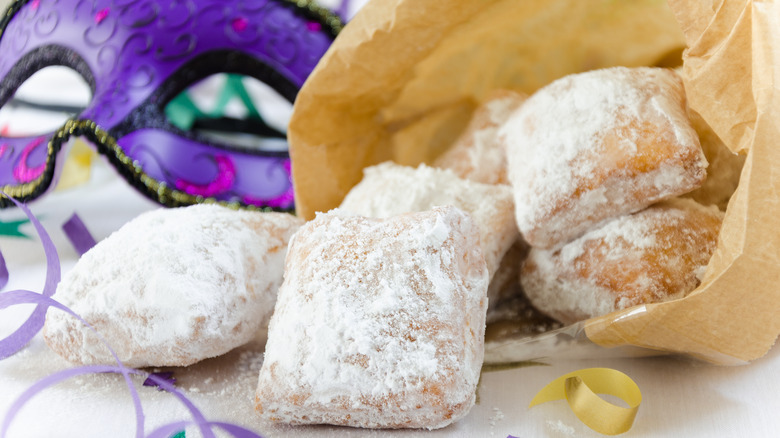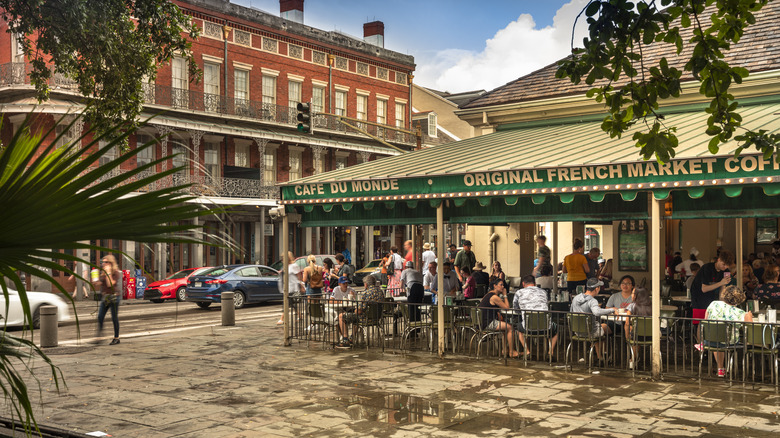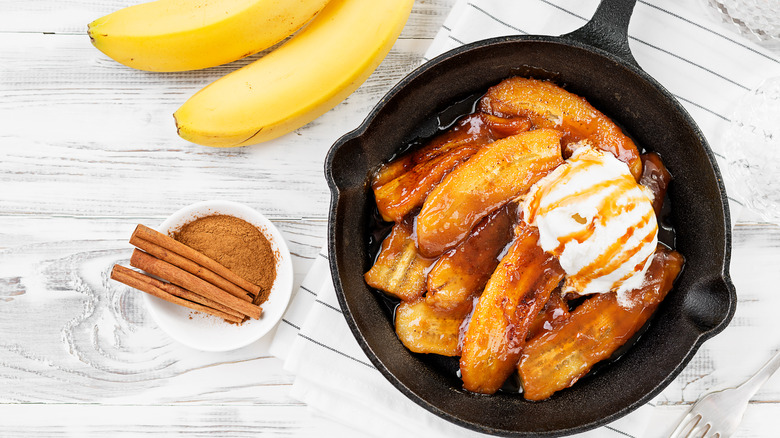How Beignets Became The Quintessential Dessert Of New Orleans
You really can't talk about New Orleans, Louisiana, without mentioning beignets. And it would be just plain wrong to visit the colorful French Creole city without eating your fill of them. The two simply go together like peanut butter and jelly. Beignets (pronounced "ben-yays") are essentially French doughnuts made from a sweet yeasted dough, cut into squares, and deep-fried until golden brown. Because they are made with a wet dough (akin to pâte à choux), steam is created when they hit the hot oil, making them light and airy. Unlike traditional doughnuts, there are no holes in beignets, which aids in holding the generous pile of powdered sugar they are typically doused in.
Even though they weren't invented in the Big Easy, beignets are unequivocally associated with the city due to their long history there. The journey began in the 17th century, when French immigrants moved west to the Acadian region of Canada. They had been making beignets in their native land for generations, and naturally brought the recipe with them. In the 18th century, thousands of these settlers were forcefully moved out of the Great White North and headed south, where they planted roots in the New Orleans area, helping to create the Cajun nation. This nation is essentially a mix of French Canadian, Native American, African American, Spanish, and Caribbean cultures. Beignets became mainly connected to the French Quarter of New Orleans, where they are still plentiful and draw people from around the globe to indulge in them.
Cafe du Monde helped put beignets on the culinary map
Many would agree that it was Cafe du Monde that acted as the trailblazer for putting beignets on the French Quarter map in New Orleans. The cafe opened in 1862 as a simple coffee stand in the midst of the famous French Market. Historically, it was a place to enjoy café au lait made with the region's signature chicory coffee and fried beignets. The Market itself has traditionally been a place of high foot traffic due to both business and tourism, and, as Cafe du Monde is an anchor of the market, its visibility has always been prominent, drawing people of all ages and social classes.
Interestingly, the donuts from Cafe du Monde weren't always called beignets. Up until 1958, the sweets were simply known as "French Market donuts," but were successfully rebranded, making it easier to set them apart from anything else labeled as a donut. Cafe du Monde is open 24 hours a day, every day of the year except Christmas Day, so the hordes of tourists (not to mention loyal locals) who visit New Orleans can easily get their hands on fresh beignets. All of this helped establish the beignet not only as an icon in the Big Easy, but also as Louisiana's official donut.
NOLA is much more than just beignets
Beignets may be the first treat that comes to mind when you think of New Orleans, but there is no doubt that this city by the bayou is one of the greatest food cities in America. Several other sweets are closely linked to Crescent City, like bananas foster, a flambéed dish made with bananas, rum, cinnamon, and banana liqueur. It was originally created by Owen Brennan of the famous restaurant, Brennan's, in the French Quarter.
Although not invented in New Orleans, the city has essentially adopted bread pudding as one of its signature dishes. With eateries all across the city offering their own spin on this humble dessert, you will find the dish everywhere from casual legends like Mother's, which makes its bread pudding with fruit cocktail, to fine dining establishments like Antoine's.
There is arguably no other American city associated with king cakes as closely as New Orleans is. Mardi Gras king cakes are colorful, seasonal treats you can find pretty much on every corner in New Orleans between January 6 and February 13, the dates during which the cake is traditionally eaten.
Clearly, if you're planning a trip to New Orleans and want to experience its signature dishes, you're going to need to plan accordingly, especially if you're going to be gobbling up beignets on a daily basis (highly recommended). After all, these were just the desserts. Digging into the savory dishes is a whole other, delicious story.



